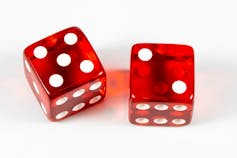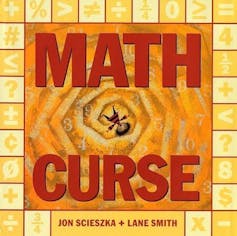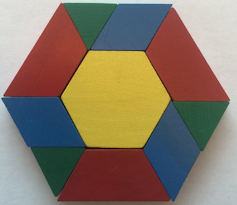In the COVID-19 pandemic, children are just as concerned as their parents about what is happening. The closure of schools is a huge upset in children’s lives. As parents support children and consider their learning, this can be an opportunity for both parents and kids to question, explore, think and learn mathematics together through everyday activities.

Much of our experience and research has led us to become increasingly convinced that changing people’s beliefs about mathematics has an impact on their confidence with mathematics and learning math.
Regardless of whether you’re personally comfortable with math, or if you’d like to improve your child’s number sense, now could be a chance for both of you to enjoy mathematics and think of the mathematics all around you.
READ MORE: ‘The math ain’t working’ — Online schooling not a smooth transition for parents during COVID-19
Dice games

(Shutterstock)
Even simple games with dice are immensely powerful.
As experienced math teachers, we can tell you: Do not underestimate how much of a valued skill it is for children to automatically recognize what number they rolled without counting the dots!
Once children can automatically tell you the number of a single die, then adding single digit amounts on the dice (like four plus six) is really helpful for working on the next step.
A game: Balloons and dice
One of the authors of this story, Ann Kajander, has a book Big Ideas for Growing Mathematicians with lots of activities to do at home. One is “Balloons and Dice.” This game lets children practice being able to add numbers together.
In this game, older children can start to appreciate the probability that is embedded in the game by recording what sums are rolled and seeing what happens most often. At this point, strategy can be used to determine where to place the coins to have a higher likelihood of winning.
You need 24 pennies, two sets of dice and a game board that looks like sideways stalls with numbers one to 12.

You can hand-draw your board game, which looks like sideways stalls with the numbers one to 12. (Jennifer Holm).

Get daily National news
Instructions:
- Place the pennies (your balloons) under any numbers you choose in your stalls.
- Each player takes turns rolling the two dice. You may “pop a balloon” if you have a penny/balloon in the stall that is the sum of your roll. (Some kids may enjoy shouting “pop!”) For instance, if you roll a three and a four, you can pop one balloon in stall No. 7.
- The first player to pop 10 balloons is the winner.

Math baking or cooking
Having your child bake or cook with you is also a powerful mathematical activity. In children’s early years, you can help them recognize the different fractional amounts and compare the sizes of the cups. As children get older, try removing some of the cups and see if they can build the fractions. For example, you only have a quarter cup, how can you make a half cup?
A great chance to practise fraction operations is to make the recipe bigger or smaller. Find a recipe for four people and figure out how much of each ingredient is needed for two people. Or, to make it more challenging, find a recipe for four people but make a batch that would feed six instead.
The practical applications might even help children forget they are doing mathematics (be sure not to tell them). But know you are building their fluency with concepts.
Other mathematical concepts can easily be brought into conversations so that children are using their mental math skills or reasoning, which is sometimes under-appreciated in mathematics.
You can also discuss ratios, for example, while making chocolate milk. When mixing it, you can talk about how many parts chocolate syrup or powder to add to the milk in order to make it sweeter or less sweet. You can experiment and test mixtures to find the ideal ratio.
READ MORE: A look at the math behind social distancing amid coronavirus
Patterns, shapes, math stories
When walking outside or wandering through the house, you can look for patterns and have your child talk about the pattern rule that tells them what comes next. Similarly, you can create a shape bingo card and have them hunt for an example of each shape in their environments.

(Penguin Random House)
This could be a great time to read mathematics-themed stories. One of our favourites is Math Curse by Jon Scieszka. It contains many fun mathematics problems that you could try solving, or just enjoy the story and start a conversation about what mathematics problems children see around them. Another great book is the Number Devil by Hans Magnus Enzensberger.
Board games like Monopoly or Snakes and Ladders have lots of math built into them.
Math problems online
You can visit the Fraction Talks website, curated by Nat Banting, a math teacher, PhD student and lecturer at the University of Saskatchewan. We love the “Manipulatives” section of the website, which gives a concrete way to determine the fractional amount.

A simple exercise is talking about what fractions are shown in the diagrams: for instance, what fraction of an image is blue?

(Fraction Talks/Nat Banting)
The website Cool Math for Kids also lets you use pattern blocks to explore the fractions pictured in the images on the site.
If you’re really looking for some fun math problems to work on communication and reasoning, try Open Middle problems where the problems have multiple correct answers and many different ways to solve them.
You can help your child see that there are different ways to solve and reason about problems. Most importantly — despite these stressful times, try to let yourself have fun.Jennifer Holm, Assistant Professor, Faculty of Education, Wilfrid Laurier University and Ann Kajander, Associate Professor of mathematics education, Lakehead University
This article is republished from The Conversation under a Creative Commons license. Read the original article.







Comments